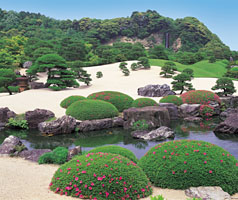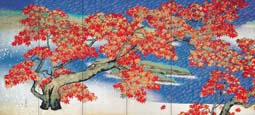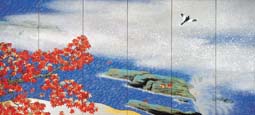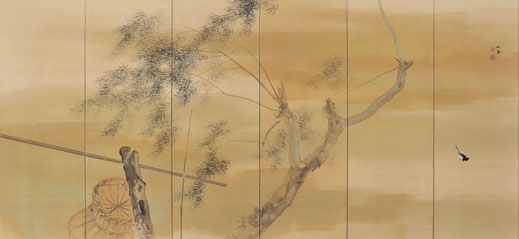 |
|
 |
The White Gravel and Pine Garden in spring, with the Kikaku waterfall in the distance.
|
|
The Dry Landscape Garden in summer, with Mt. Katsuyama in the background. |
 |
|
 |
| The garden of the Juryu-an teahouse in autumn. |
|
The Pond Garden and Seifu teahouse in winter. |
Visitors to Japan generally hear of the Adachi Museum of Art in the context of its renowned gardens, which consistently win top rankings from sources like Michelin and the Journal of Japanese Gardening. The museum's landscaping is indeed spectacular: acres of meticulously arranged rocks, moss, trees, and sand set against an unspoiled mountain backdrop, with a waterfall in the distance for good measure. This alone is well worth the trip to a somewhat out-of-the-way corner of Japan, but it would be a shame to overlook the art collection, for there are stunning views to be had indoors as well.
Located in the foothills of the Chugoku mountains a few miles inland from the Japan Sea, the museum is the brainchild of one man, Zenko Adachi (1899-1990). Born into poverty in Yasugi, Shimane Prefecture, he made his fortune in textiles in Osaka after World War II. A lover of both Japanese gardens and Japanese art, he built a museum designed to showcase both passions in a mutually enhancing way.
The first building of the museum opened in 1970 on a large tract of land close by Zenko's birthplace; the property has since grown to nearly 200,000 square meters. Over the next few years Zenko added new wings and commissioned some of Japan's finest landscape designers to gradually ring the long, rambling structure with six gardens of varying themes. Some focus on a defining element -- a pond or a teahouse; others on materials -- moss, or white gravel and pine trees. The most dramatic view is of the two largest gardens, which adjoin one another to form an unbroken chain of vistas that can be enjoyed from the bank of windows along that side of the museum. Given the hordes of visitors that the daily flotilla of tour buses unloads at the Adachi, it is probably just as well (though a tad disappointing) that the gardens are made for viewing from behind a window, not for strolling in.
 |
|
 |
The museum viewed from the Dry Landscape Garden; note the bank of picture windows facing the garden.
|
|
The Yokoyama Exhibition Room, with Autumn Leaves on the far wall. |
 |
|
 |
| Taikan Yokoyama, Autumn Leaves (1931), left and right screens, collection of the Adachi Museum of Art. |
Before viewing the museum's collection, visitors are encouraged to stop and savor the panorama through the picture windows that line the long corridor to the exhibition rooms. Indeed, the Adachi makes a point of framing these views as if they were works of art on a wall. As in art, there is an element of contrivance in the landscape one sees through the frame. The sightlines to what appears to be a pristine expanse of natural beauty extending far beyond the gardens cleverly conceal the paved road, passing cars, rice fields and houses that nestle -- utterly out of sight -- between the garden perimeter and the hills beyond. The waterfall, too, is artificial, but so authentic-looking as it pours off a distant cliff that the museum takes pains to inform visitors that this, too, is part of the design. For this brilliantly executed trompe-l'oeil, the Adachi gardens are rightly hailed as one of the world's most sublime examples of
shakkei -- the use of surrounding scenery to enhance a man-made landscape.
Since the museum focuses primarily on Nihonga, in which natural motifs predominate, the transition from garden to art is remarkably seamless. By the time you arrive at the first gallery, your eyes and soul should be in an appropriately soothed state to derive maximum enjoyment from the collection. Pride of place at the Adachi goes to Taikan Yokoyama (1868-1958), who gets his own exhibition room; Zenko loved this artist above all others and devoted himself to acquiring his works. Today the museum owns 120 of his pieces, arguably the biggest and best Taikan collection in the world.
Taikan was a seminal figure in the development of Nihonga, a relatively recent genre -- the term did not even exist until after the Meiji Restoration, and was coined to differentiate traditional Japanese-style painting from the Western-style art then coming into vogue. Nihonga artists are traditional mainly in their choice of materials, which consist of sumi ink or water-soluble natural pigments applied by brush to washi paper or silk. Though Nihonga motifs and techniques, too, initially hewed to the traditions of Yamato-e and the Kano and Rinpa schools, Taikan and his contemporaries introduced new, often Western-derived elements into their work. One of the most revolutionary was the elimination of outlines in favor of what conservative critics of the day called
morotai -- "blurred style." It was not intended as a compliment.
 |
|
 |
| Seiho Takeuchi, After a Shower (1928), left and right screens, collection of the Adachi Museum of Art. |
The centerpiece of the Adachi's Taikan collection is
Autumn Leaves, a gorgeous screen painting of scarlet maple leaves against the ultramarine backdrop of a mountain stream, spreading across twelve panels that cover one entire wall of the Taikan Room. But the museum also boasts a roomful of masterpieces by other celebrated Nihonga artists, and often features particular artists or themes in rotating exhibitions.
The current Spring Exhibition, "Confrontation between Top Two Masters," hints at conflict -- where really there was none -- between Taikan, who lived in Tokyo, and his contemporary Seiho Takeuchi (1864-1942), based in Kyoto. Seiho was just as brilliant an innovator as Taikan, blending elements of Western realism with traditional Japanese techniques, but in a different manner from his "rival." The show encourages comparisons between the two masters' approaches to the same motif, as with the waterfalls shown here.
To the Adachi's credit, it has not contented itself with amassing works from the pre-World War II "golden age" of Nihonga. Two years ago it opened an annex devoted to contemporary Nihonga artists, not a few of whom deserve global recognition. In the early postwar years, many of these artists departed entirely from traditional motifs and, inspired by travels to far corners of the world, employed the distinctive materials and coloring of Nihonga to depict scenes in India, China, Africa, Paris or Rome. Their work testifies to the staying power of Nihonga as a medium today, and the Adachi is a superb venue in which to explore the genre in its many permutations. Even without the gardens, it's an imperative destination for anyone interested in the evolution of Japanese art. Then again, one could say the same thing about the gardens themselves.
 |
|
 |
| Taikan Yokoyama, Waterfall in Nachi (1915), collection of the Adachi Museum of Art. |
|
Seiho Takeuchi, Waterfall (1925), collection of the Adachi Museum of Art.
All images courtesy of the Adachi Museum of Art
|